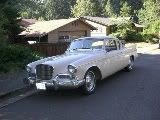Until a few months ago (2-3) I had the standard coil on my 62 Hawk. I used the resistor wire. I thought I was having coil problems and purchased a Pertronix Flamethrower, 1.5 ohm internal resistor. I bypassed the resistor wire and connected a wire from the ignition switch to the coil as instructed in the Pertronix instructions that came with the coil. I finally switched to a Pertronix Ignitor system to replace the points. Everything worked great!! Then I started having missing problems with the engine. Thinking it was Carb related I started examining the Carb. Saw the PErtronix coil was leaking!! There was a crack completely around the tower, next to the output. (See earlier post entitled: "What the Heck") Wrote PErtronix twice and was told twice that absolutely that a resistor was not necessary!!
Nevertheless, seeing that the coil was getting rather hot (I don't think I could have held it in my hand very long!), I decided to take everyone's advice and add a resistor. I did so and added a 1.5 ohm external resistor, hoping the coil would run cooler. I drove the car a good bit today and when I got home checked to see if the coil was hot. I touched it with my bare hand and it is still getting too hot to hold very long. (Sorry that's the best I can describe how hot is it getting) This is the second PErtronix and I don't want to burn it up too. In fact, I haven't even sent the last coil back to PErtronix for them to replace it!!!
The question is how hot should the coil get?
Laisez le bon temps roulez avec un Studebaker
Nevertheless, seeing that the coil was getting rather hot (I don't think I could have held it in my hand very long!), I decided to take everyone's advice and add a resistor. I did so and added a 1.5 ohm external resistor, hoping the coil would run cooler. I drove the car a good bit today and when I got home checked to see if the coil was hot. I touched it with my bare hand and it is still getting too hot to hold very long. (Sorry that's the best I can describe how hot is it getting) This is the second PErtronix and I don't want to burn it up too. In fact, I haven't even sent the last coil back to PErtronix for them to replace it!!!
The question is how hot should the coil get?
Laisez le bon temps roulez avec un Studebaker



 DESEE
DESEE

Comment